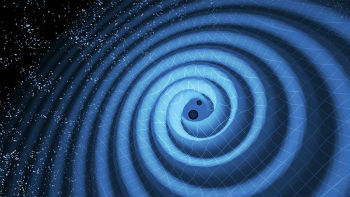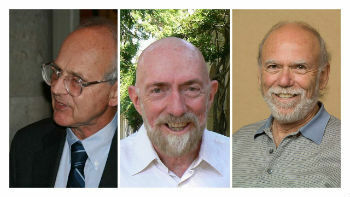Gravitational waves are ripples in the curvature of spacetime that propagate through space.
They are transverse waves that travel at the speed of light being emitted by violent collisions that happen in the Universe.
In practice, it is extremely difficult to directly detect the presence of gravitational waves because the elongation and compression of spacetime is very small.
The primordial gravitational waves are those that resulted in the origin of the Universe, as explained in the Big Bang Theory.

Fusion of two black holes and propagation of gravitational waves
Gravitational Waves and Einstein
Was Albert Einstein (1879-1955) who suggested the existence of gravitational waves in the Theory of General Relativity.
In 1915, Einstein had concluded that the gravity it was a deformation of spacetime.
The physicist developed the theoretical basis, but failed to prove the existence of gravitational waves. Just 100 years later, the scientific community celebrated the capture of waves.
2017 Nobel Prize in Physics
On October 3, 2017, researchers Rainer Weiss (MIT), Barry Barish and Kip Thorne (Caltech) were awarded the Nobel Prize in Physics. They first detected gravitational waves in September 2015.
It was the recognition of a work that began in the late sixties.
Scientists believe that capturing gravitational waves will allow us to observe the universe in a new way, providing a broader understanding of the world around us.

Rainer Weiss, Kip Thorne and Barry Barish, 2017 Nobel Prize winners in Physics
Wave Detection in 2015
Gravitational waves were detected for the first time in the United States on September 14, 2015 at exactly 06:50:45 (Brasilia time).
How did it happen?
They arose from the shock of black holes with 36 and 29 solar masses (36 Msol and 29 Msol respectively) and occurred at a distance of 1.3 billion light years.
As they lose energy, black holes get closer, which makes them spin faster.
This continuous movement, around each other, causes them to collide, which results in gravitational waves.
The announcement of wave detection was made by David Reitze, project director, just months later, in February 2016.
That same year, in June 2016, gravitational waves were detected again.
This time, the black holes were respectively 14 and 8 times the mass of the Sun (14 Msol and 8 Msol) and occurred at a distance of 1.4 billion light-years.
Listen here to the sound of gravitational waves:
LIGO - Gravitational Wave Observatory
The proof was made possible thanks to the Ligo detector project - Laser Interferometer Gravitational Wave Observatory (Observatory of Gravitational Waves by Laser Interferometry).
In the project, two interferometers were built in the United States, about 3000 kilometers apart: one in Livingston, Louisiana, and the other in Hanford, Washington.
The system is formed by two perpendicular arms 4 kilometers long. It also has devices that eliminate noise from different wave sources, such as earthquakes.
The interferometer consists of a light source (laser), a mirror at the end of each arm, a mirror that splits the light beam in two, and a photodetector.
The operation of LIGO dates back to 2002. Between 2010 and 2015 its operation was interrupted for an update process, which seems to have worked, considering that the great scientific achievement took place that year.

LIGO - Detector in Livingston, Louisiana
Detectors around the World
In addition to the existing detectors in the United States, there are a dozen more spread across 9 countries.
In Brazil, we have the Mário Schenberg Gravitational Wave Detector from the USP Physics Institute. The beginning of its construction dates back to the year 2000 and is the result of a project called graviton.
The project has researchers from INPE (National Institute for Space Research), from Cefetsp (Federal Center for São Paulo Technological Education, ITA (Technological Institute of Aeronautics) and Uniban (University Bandeirante).
Time travel
The proof of waves was, without a doubt, a unique moment for scientists of this century. This opened the way for new studies of Gravitational Astronomy.
Perhaps, this proof can enable a time travel, as in the movie "Back to the future".
Read too:
- Theory of relativity
- Big Bang Theory
- waves

